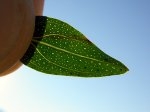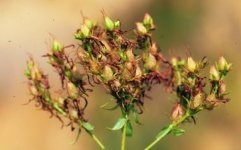St. John's Wort
Hypericum perforatum
Native to Eurasia and Northern Africa, St. John's Wort is a perennial that forms dense stands and displaces native vegetation. It also contains a toxin that causes skin irritation and blistering in light-coloured livestock when they are exposed to sunlight.
St. John's Wort prefers dry sandy soils and full sun. It can be found along roadsides and rail lines, in grasslands, open forests, grazing and disturbed areas. It is also able to invade healthy range lands, reducing wildlife and livestock forage.

Roots spread outwards and are capable of forming new buds. Stems are rust-red in colour and can grow up to 1 m tall; there can be multiple stems per plant. Leaves have prominent veins and are covered with dots that are transparent when held to the light. Flowers are yellow, have five petals and numerous. They grow in clusters where their can be 25-100 flowers per cluster. Numerous seeds are contained in a pod and one plant can produce over 100,000 seeds per year and can remain viable for 10 years. Seeds are dispersed by wind and animals.
Information provided by USDA Forest Service: Northeastern Area
Â
Seeds

Â
Resources
St. John's Wort ISCM Fact Sheet
Alberta Invasive Plant Council Fact Sheet
2011 Rural Municipality Distribution Map
2010 Rural Municipality Distribution Map
St. John's Wort MWSA 2009 Survey Map
Â
Back to Terrestrial Invasive Species List
Â
Â
© Copyright 2004-2025 - CMS Made Simple
This site is powered by CMS Made Simple version 1.4.1


